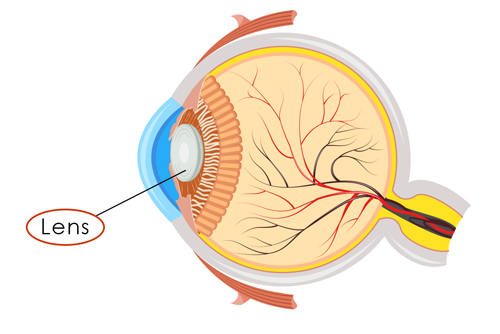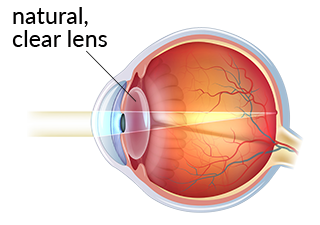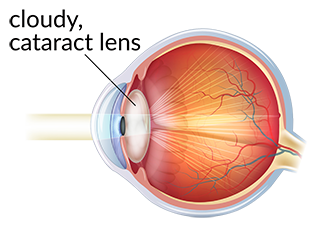
Improve Your Vision With Cataract Surgery
What Everyone Should Know About Cataracts
Having a cataract can be a good thing! A cataract develops when proteins in the lens of the eye begin to clump together forming clusters that eventually cloud your natural lens. These clusters allow less light to pass through the lens causing issues such as cloudy vision and difficulty seeing at night.
Terms To Know
- cataract: A clouding in the lens often due to the aging of the eye. This change in the protein and fibers of the lens cause cloudy or hazy vision, faded colors, glare, double vision, or difficulty seeing at night.
- lens: The clear part of your eye that helps focus light on the retina, kind of like a camera. The lens provides 30 percent of our focusing power and the cornea (the clear front-most part of your eye) the other 70 percent.
Cataracts and Your Vision
Cataracts are a natural part of aging and affect everyone as they get older. In fact, an estimated 20.5 million Americans over age 40 have cataracts.2 When you have cataract surgery, not only does your vision improve, but depending on which IOL you choose, you can be less dependent on glasses than before developing the cataract.
Risks and Prevention of Cataracts
Some risk factors for cataracts, aside from the natural aging of the eye, include: eye trauma or surgery, longterm use of certain medications, exposure to radiation, X-rays or UV light, or diseases such as diabetes, hypothyroidism, and glaucoma.
The most common cause of a cataract is aging so eventually everyone is at risk. Other factors that may increase your risk or early development of a cataract include:
- Longterm use of steroid medication
- Smoking
- Obesity
- High blood pressure
- Previous eye injury or eye surgery
- Family history of cataracts
There is no way to prevent cataracts from developing but you can slow their progression. Eating a healthy diet rich in green leafy vegetables and omega-3 fatty acids is excellent for your overall eye health. Always protect your eyes with UV protection in sunglasses and daily vision correction.
Three Types of Age-Related Cataracts
There are three common types of age-related cataracts:4
- A Nuclear Cataract is the most common type of cataract caused by the gradual protein build up in the center area of the natural lens of our eye as we age. Vision loss is gradual and, if not surgically removed, the cataract will continue to worsen over time.
- A Posterior Subcapsular Cataract is a small, opaque cloudy area that develops on the back of the lens. This type of cataract is most common in people who are taking high doses of steroid medications, or have glaucoma, diabetes, or retinal issues. It can develop more rapidly and patients detect vision changes earlier.
- A Cortical Cataract causes white streaks or wedge-shaped opacities to develop at the edge of the lens and in toward the center. The progression of cortical cataracts varies over months or years.
Although most cataracts are age-related, cataracts can also develop after an eye trauma, after exposure to radiation, and sometimes babies are born with cataracts or develop them in childhood.
Million over 40 affected by cataracts^
Surgeries in the US each year†
%
Overall success rate~
million over 40 affected by cataracts^
Surgeries in the US each year†
%
Overall success rate~
How Cataracts Affect Your Vision
A common misconception is that a cataract is a “film” that develops on the eye. In fact, a cataract forms when protein clusters develop inside the eye’s natural lens. The lens becomes cloudy and hard allowing less light to pass through the eye.


Do I Have A Cataract?
Since cataracts develop slowly over time, it is possible to have a cataract and not even know it is distorting your vision. You may have even made lifestyle modifications, such as not driving at night, to adapt to your changing sight.
Symptoms
When a cataract is developing, the normally clear lens of the eye is cloudy causing images to not focus clearly on the retina. Some common symptoms of a cataract include:
- Cloudy or blurry vision
- Glare or “halos” when driving at night
- Trouble reading in dim light
- Can’t seem to get the right eyeglasses prescription
- Vision is more blurry
- Colors seem yellowed or faded
- Double vision in one eye
- Sensitivity to light
Diagnosis
Since cataracts are related to the natural age of the eye, they are most common in people 55 and over. By age 80, 50 percent of Americans either have cataracts or have had them removed.5
Regular eye exams are the best way to diagnose and monitor cataracts. Through a dilated exam (where the pupil is enlarged), your eye doctor can examine the lens of your eye and the visual pathway to the retina at the back of your eye.
As the cataract slowly progresses, you can change your glasses prescription to help compensate for some of the symptoms of the clouding lens. When glasses no longer provide clear vision and the cataract is affecting your daily activities, it is time to consider having it removed through cataract surgery.
Wake Up and SEE the Coffee!
The Benefits of Cataract Surgery

When you replace the cataractous lens with an intraocular lens implant (IOL) through cataract surgery, your surgeon chooses the lens based on your prescription. This customized lens lessens your dependence on glasses helping you enjoy vision you may not have had in years! Some advanced lens options improve your distance and reading vision. Click here to learn more.

Written By: Kimberley Bader, Patient Education Coordinator
Reviewed By: Shawn Parker, MD, FACS
Last Updated: January 26, 2020
SOURCES / REFERENCES:
1,† “Cataract surgery: replacing your cloudy lens.” Alcon, a Novartis Division, Web. Accessed April 3, 2017.
2,^ “Common Eye Disorders – Cataract.” Centers for Disease Control and Prevention (CDC), Web. Sep 2015. Accessed April 3, 2017.
3 “Facts About Cataract – Is cataract surgery effective?” National Eye Institute, Web. Sep 2015. Accessed April 3, 2017.
4 “What Are Cataracts? – Types of Cataracts” Alcon, a Novartis Division, Web. Accessed March 28, 2017
5 “Eye Health Information: Cataract” National Eye Institute (NEI), Web. Accessed April 3, 2017
6 “Treating Cataracts with Surgery – Understanding the Surgery” Alcon, a Novartis Division, Web. Accessed April 3, 2017.
7 “Wilmer Eye Institute: Cataracts FAQ – Prognosis” Johns Hopkins Medicine, Web. Accessed April 3, 2017.
8,~ “My Cataract Journey – Potential Risks and Complications” All About Vision, Web. Accessed March 28, 2017.
9 “Cataract Surgery: What is a secondary cataract.” American Optometric Association (AOA), Web. Accessed March 28, 2017.
![]()

